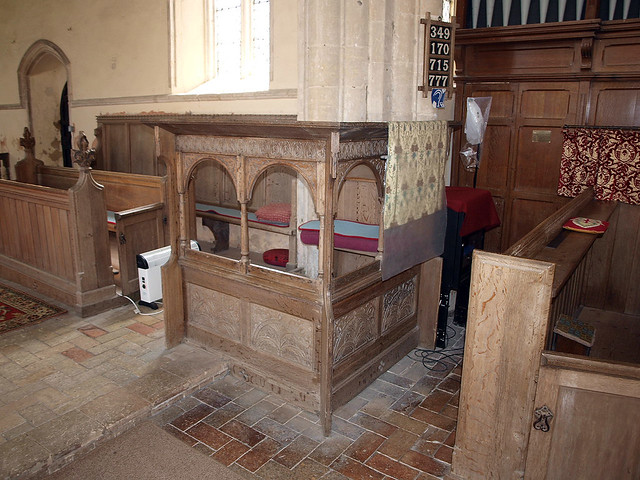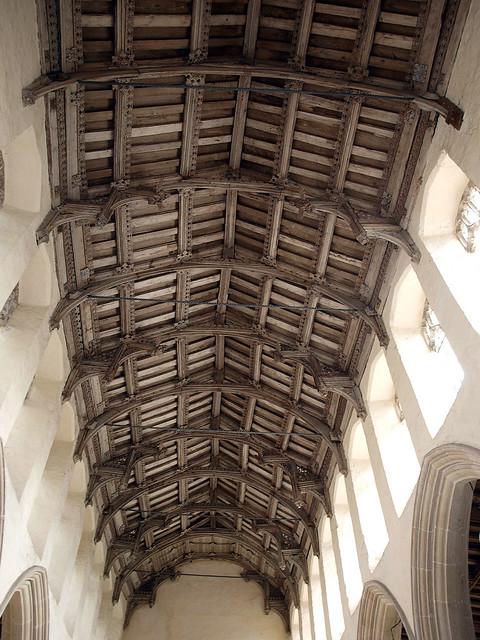ST ANDREW. Almost entirely Dec. Chancel with an original tracery design. Five lights, above them four spherical triangles, forming the main ogee arches, and above them one large reticulation unit. The side windows of the chancel are segment-headed. To the l. and r. of the E window niches outside. Inside ogee-arched PISCINA and SEDILIA. Of the sedilia the two seats and arches broken off which stood against the window. Aisles with segment-headed two-light windows, either with one spherical triangle or with reticulation motifs treated again very originally. The latter type of window also in the s porch. The five-bay aisle arcades have the typical early C14 piers: quatrefoil with fine diagonal spurs. The arch is moulded in two waves. The S porch has a parapet with flushwork decoration. Porch entrance with leaf capitals. Delightful S doorway with three orders of shafts all with leaf capitals. In the arch one order closely carved with leaves. The hood-mould also treated in this way. It rests on the l. on a big lizard. There is exceptionally much of the original colour preserved. Equally startling the W tower. Its W side is opened by a tall arch all the height which is usually occupied by doorway and window. It forms quite a spectacular W porch. At its E, however, there is no doorway, only a fine Dec three-light window. The Perp contribution is the clerestory and the roof.* The clerestory has doubled windows ; they are of two lights with panel tracery. The arches with some brick voussoirs. Flushwork emblems between the windows. The roof has double-hammerbeams with collars alternating with arched braces up to the collars. Angels remain against the upper hammerbeams. The purlins have fine crestings. The E bay is boarded, but nothing of its decoration survives. - FONT. The stem with eight small figures (monks? bedesmen?). The bowl is not original. - PULPIT. Jacobean. - READER’S DESK. Made up of Jacobean parts. - BENCHES. One with poppy-heads, and on one end the carving of an iron-bound door. The others plain and solid, straight-headed. - COMMUNION RAIL. With turned balusters; C17. - DOORS. The S door with tracery of reticulation motifs. - The door to the tower stairs is all iron-faced. - STAINED GLASS. Fragments in the aisles and in the N clerestory. - PLATE. Cup probably c. 1600; Paten c. 1675; Flagon 1727.
* A will of 1471 gives a close called Garlekis for the repair and building of the new roof - on condition that no man of Cotton unjustly claims or induces a disturbance in his close called Clarys Close in Cotton (ARA).
COTTON. About a mile from Finningham we come to it, to find several old moated houses and its old hall now a farm. The church has happily preserved some of the lovely things created for it 500 years ago. In its wide porch we stay to admire the charming tracery of two early unglazed windows, and the equally charming tracery of the east window filled with old green glass. The doorway is carved with oak and vine leaves. The north door is guarded by a heavy oak bar.
The 14th century nave arcade, to which a clerestory was added 500 years ago, has graceful clustered shafts and moulded capitals. Some early craftsman who loved the saints has carved canopied niches for them here and there about the church- - on the outer buttress of the east wall, and, wreathed with foliage, above the double piscina and sedilia. Four steep and narrow steps lead up to the pretty little Jacobean pulpit. There are carved figures round the shaft of the font, and fine work on the pillars of the oak altar rail.
In one of the aisle windows are small figures of prophets and a headless figure of Christ in painted glass thought to be 14th century, and in the clerestory windows are 15th century angels of lovely colouring. From the fine hammerbeam roof, with carved cornices, are angels looking down on all the beauty below.



No comments:
Post a Comment